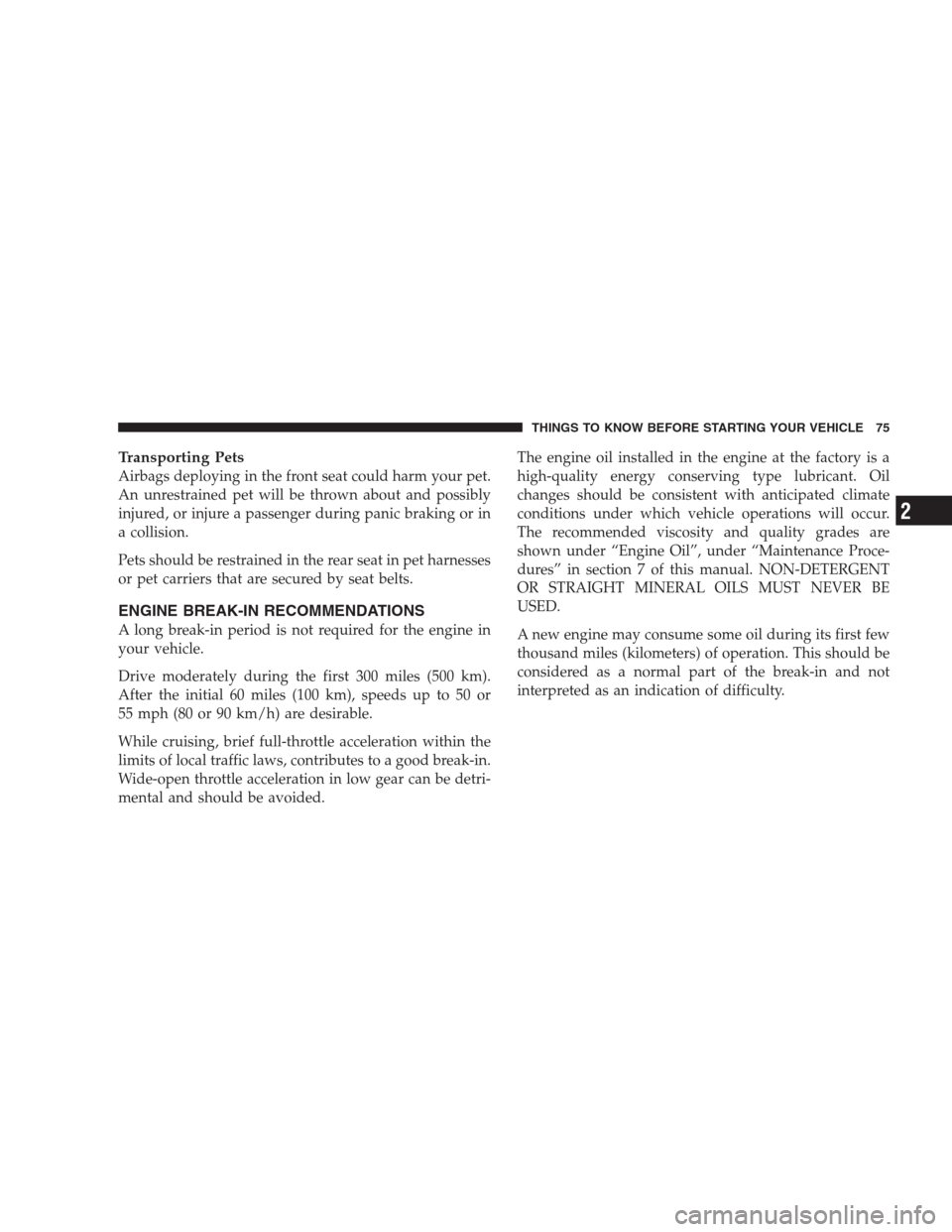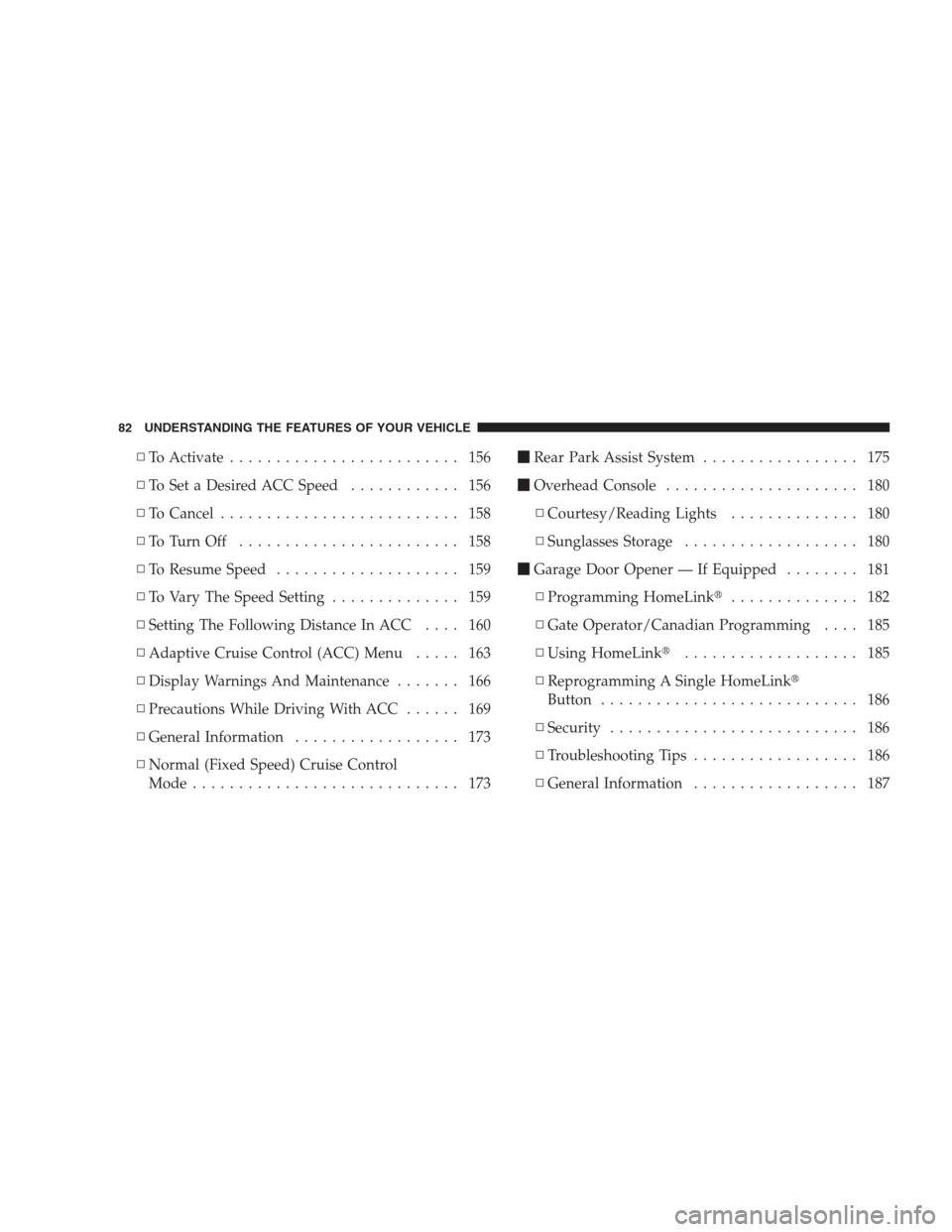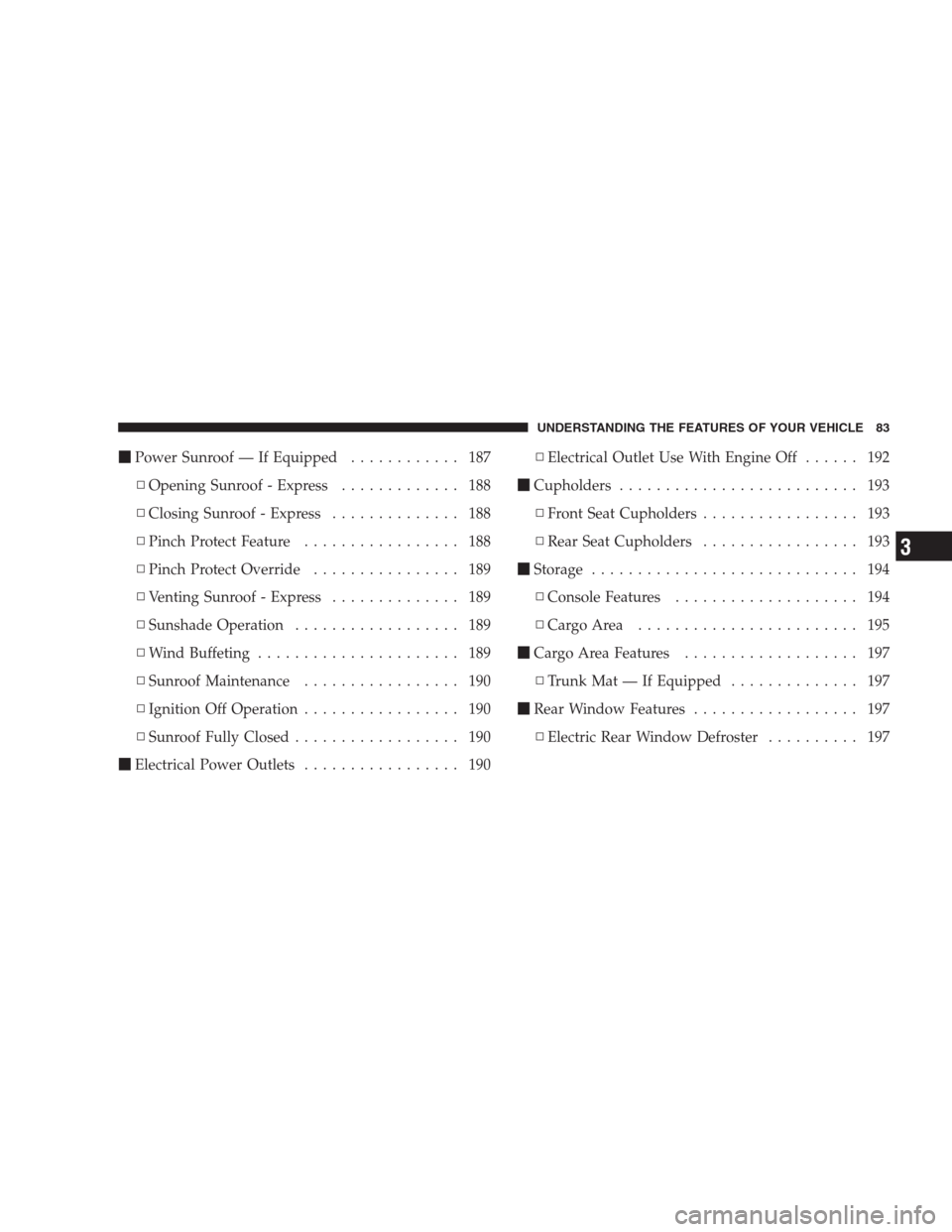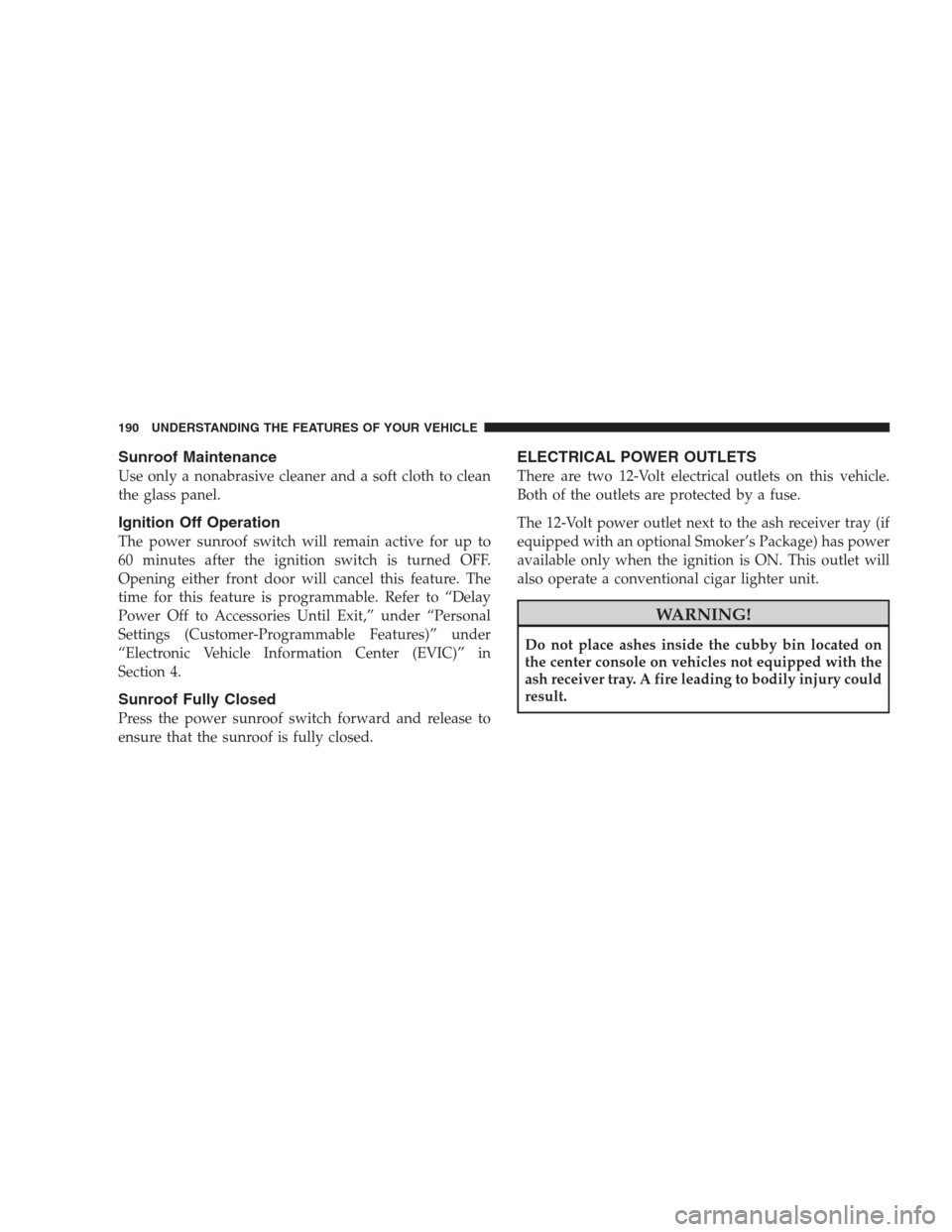Page 3 of 493
TABLE OF CONTENTSSECTIONPAGE
1INTRODUCTION.............................................................3
2THINGS TO KNOW BEFORE STARTING YOUR VEHICLE..............................9
3UNDERSTANDING THE FEATURES OF YOUR VEHICLE..............................79
4UNDERSTANDING YOUR INSTRUMENT PANEL.................................. 199
5STARTING AND OPERATING................................................. 303
6WHAT TO DO IN EMERGENCIES...............................................377
7MAINTAINING YOUR VEHICLE............................................... 393
8MAINTENANCE SCHEDULES................................................. 441
9IF YOU NEED CONSUMER ASSISTANCE.........................................459
10INDEX....................................................................469
1
2
3
4
5
6
7
8
9
10
Page 6 of 493

INTRODUCTION
This Owner’s Manual has been prepared with the assis-
tance of service and engineering specialists to acquaint
you with the operation and maintenance of your vehicle.
It is supplemented by a Warranty Information Booklet
and various customer-oriented documents. You are
urged to read these publications carefully. Following the
instructions and recommendations in this manual will
help assure safe and enjoyable operation of your vehicle.
NOTE: After you read the manual, it should be stored
in the vehicle for convenient reference and remain with
the vehicle when sold, so that the new owner will be
aware of all safety warnings.
When it comes to service, remember that your authorized
dealer knows your vehicle best, has the factory-trained
technicians and genuine Mopar�parts, and is interested
in your satisfaction.
HOW TO USE THIS MANUAL
Consult the Table of Contents to determine which section
contains the information you desire.
The detailed Index at the back of this Owner’s Manual
contains a complete listing of all subjects.
Consult the following table for a description of the
symbols that may be used on your vehicle or throughout
this Owner’s Manual:
4 INTRODUCTION
Page 77 of 493

Transporting Pets
Airbags deploying in the front seat could harm your pet.
An unrestrained pet will be thrown about and possibly
injured, or injure a passenger during panic braking or in
a collision.
Pets should be restrained in the rear seat in pet harnesses
or pet carriers that are secured by seat belts.
ENGINE BREAK-IN RECOMMENDATIONS
A long break-in period is not required for the engine in
your vehicle.
Drive moderately during the first 300 miles (500 km).
After the initial 60 miles (100 km), speeds up to 50 or
55 mph (80 or 90 km/h) are desirable.
While cruising, brief full-throttle acceleration within the
limits of local traffic laws, contributes to a good break-in.
Wide-open throttle acceleration in low gear can be detri-
mental and should be avoided.The engine oil installed in the engine at the factory is a
high-quality energy conserving type lubricant. Oil
changes should be consistent with anticipated climate
conditions under which vehicle operations will occur.
The recommended viscosity and quality grades are
shown under “Engine Oil”, under “Maintenance Proce-
dures” in section 7 of this manual. NON-DETERGENT
OR STRAIGHT MINERAL OILS MUST NEVER BE
USED.
A new engine may consume some oil during its first few
thousand miles (kilometers) of operation. This should be
considered as a normal part of the break-in and not
interpreted as an indication of difficulty.
THINGS TO KNOW BEFORE STARTING YOUR VEHICLE 75
2
Page 84 of 493

▫To Activate......................... 156
▫To Set a Desired ACC Speed............ 156
▫To Cancel.......................... 158
▫ToTurnOff ........................ 158
▫To Resume Speed.................... 159
▫To Vary The Speed Setting.............. 159
▫Setting The Following Distance In ACC.... 160
▫Adaptive Cruise Control (ACC) Menu..... 163
▫Display Warnings And Maintenance....... 166
▫Precautions While Driving With ACC...... 169
▫General Information.................. 173
▫Normal (Fixed Speed) Cruise Control
Mode............................. 173�Rear Park Assist System................. 175
�Overhead Console..................... 180
▫Courtesy/Reading Lights.............. 180
▫Sunglasses Storage................... 180
�Garage Door Opener — If Equipped........ 181
▫Programming HomeLink�.............. 182
▫Gate Operator/Canadian Programming.... 185
▫Using HomeLink�................... 185
▫Reprogramming A Single HomeLink�
Button............................ 186
▫Security........................... 186
▫Troubleshooting Tips.................. 186
▫General Information.................. 187
82 UNDERSTANDING THE FEATURES OF YOUR VEHICLE
Page 85 of 493

�Power Sunroof — If Equipped............ 187
▫Opening Sunroof - Express............. 188
▫Closing Sunroof - Express.............. 188
▫Pinch Protect Feature................. 188
▫Pinch Protect Override................ 189
▫Venting Sunroof - Express.............. 189
▫Sunshade Operation.................. 189
▫Wind Buffeting...................... 189
▫Sunroof Maintenance................. 190
▫Ignition Off Operation................. 190
▫Sunroof Fully Closed.................. 190
�Electrical Power Outlets................. 190▫Electrical Outlet Use With Engine Off...... 192
�Cupholders.......................... 193
▫Front Seat Cupholders................. 193
▫Rear Seat Cupholders................. 193
�Storage............................. 194
▫Console Features.................... 194
▫CargoArea ........................ 195
�Cargo Area Features................... 197
▫Trunk Mat — If Equipped.............. 197
�Rear Window Features.................. 197
▫Electric Rear Window Defroster.......... 197
UNDERSTANDING THE FEATURES OF YOUR VEHICLE 83
3
Page 168 of 493
Display Warnings and Maintenance
ACC Blinded Warning
The ACC Blinded Warning will display when conditions
temporarily limit system performance. This most often
occurs at times of poor visibility, such as in snow, fog,
heavy rain, or when driving into direct sunlight (sunrise
or sunset). The ACC system may also become tempo-
rarily blinded due to obstructions, such as dirt or ice. In
these cases, the EVIC will display “ACC Blinded” and
the system will deactivate.
NOTE:If the ACC Blinded Warning is active Normal
(Fixed Speed) Cruise Control is still available. For addi-
tional information refer to “Normal (Fixed Speed) Cruise
Control Mode” in this section.
166 UNDERSTANDING THE FEATURES OF YOUR VEHICLE
Page 169 of 493

If weather conditions are not a factor, the driver should
examine the sensor. It may require cleaning or removal of
an obstruction. The sensor is located behind the grille,
slightly offset from the center of the grille.
To keep the ACC System operating properly, it is impor-
tant to note the following maintenance items:•Always keep the sensor clean. Carefully wipe the
sensor lens with a soft cloth. Be cautious not to
damage the sensor lens.
•Do not remove any screws from the sensor or the
sensor mount. Doing so could cause an ACC system
malfunction or failure and require a sensor realign-
ment.
•If the sensor is damaged due to an accident, see your
authorized dealer for service.
•Do not attach or install any accessories near the sensor,
including transparent material or aftermarket grilles.
Doing so could cause an ACC system failure or
malfunction.
When the condition that deactivated the system is no
longer present, the system will return to the “CRUISE
OFF” state and will resume function by simply reactivat-
ing it.
ACC Sensor Location
UNDERSTANDING THE FEATURES OF YOUR VEHICLE 167
3
Page 192 of 493

Sunroof Maintenance
Use only a nonabrasive cleaner and a soft cloth to clean
the glass panel.
Ignition Off Operation
The power sunroof switch will remain active for up to
60 minutes after the ignition switch is turned OFF.
Opening either front door will cancel this feature. The
time for this feature is programmable. Refer to “Delay
Power Off to Accessories Until Exit,” under “Personal
Settings (Customer-Programmable Features)” under
“Electronic Vehicle Information Center (EVIC)” in
Section 4.
Sunroof Fully Closed
Press the power sunroof switch forward and release to
ensure that the sunroof is fully closed.
ELECTRICAL POWER OUTLETS
There are two 12-Volt electrical outlets on this vehicle.
Both of the outlets are protected by a fuse.
The 12-Volt power outlet next to the ash receiver tray (if
equipped with an optional Smoker’s Package) has power
available only when the ignition is ON. This outlet will
also operate a conventional cigar lighter unit.
WARNING!
Do not place ashes inside the cubby bin located on
the center console on vehicles not equipped with the
ash receiver tray. A fire leading to bodily injury could
result.
190 UNDERSTANDING THE FEATURES OF YOUR VEHICLE